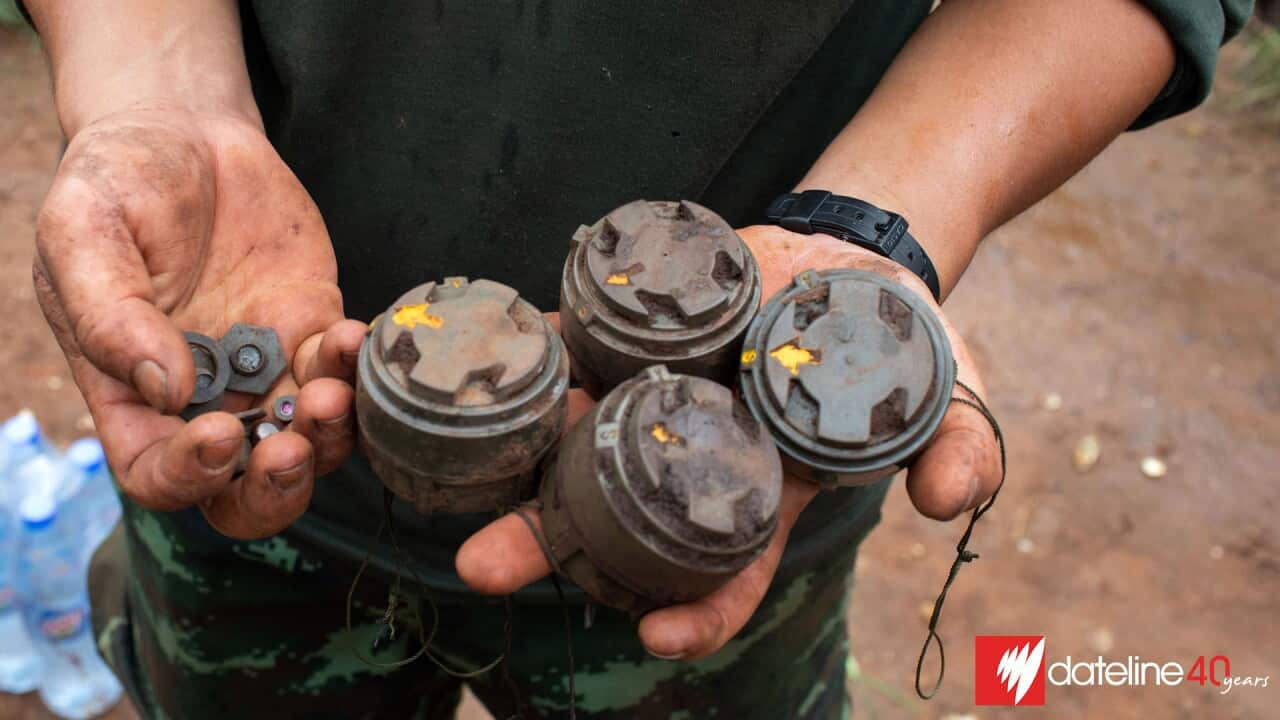On 15 October 2023, 19-year-old labourer Thet Shin was heading east, near the Thai border in his home state of Kayin in southeastern Myanmar. It had been more than two-and-a-half years since the nation erupted into civil war, but he didn't think that on this particular day, he should have been treading with any more caution than usual. He didn't suspect that the route he was taking passed through an area rigged with landmines.
Then he stepped on one.
"It's hard to put into words what I feel after stepping on that mine," he told SBS Dateline. "Life isn't the same; I can't be like [I was] before. I feel sad when I see other people walking on their two feet."
Thet Shin's leg, mutilated by the blast, was amputated almost immediately, and he received an injection to stop him from bleeding out. At the time of writing, he was still recovering, alone, at a hospital in Thailand.
Myanmar is the only nation in the world whose military actively uses landmines against its own civilian population. But it isn't just the ruling military junta that is wielding these devastating and indiscriminate weapons.
Armed actors from both sides of the conflict, including parts of the resistance, are increasingly deploying mines and improvised explosive devices (IEDs) to both protect territory and attack opponents.
The use of such armaments accelerated in the wake of , when the military and seized control of the country. In the three years since, a growing resistance movement, spearheaded by a scattered network of People's Defence Forces and ethnic armed organisations, has waged war on an increasingly embattled and belligerent military regime.
An estimated 50,000 people have been killed since the coup, including at least 8,000 civilians, according to the Armed Conflict Location and Event Data Project (ACLED), which identifies Myanmar as the most violent among the 50 wars it tracks globally. More than 500 people were killed by landmines in the country in 2022, according to the latest annual report by the International Campaign to Ban Landmines – a number surpassed only by Syria and Ukraine.

Myanmar is the only nation in the world whose military actively uses landmines against its own civilian population. But it isn’t just the ruling military junta that is wielding these devastating and indiscriminate weapons. Source: AFP / STR via Getty Images
On 25 July 2023, four children were killed by a mine that local villagers said had been planted by junta forces. The children — three of them aged five and one aged 12 — were playing in a field near their village when they stepped on the explosive.
Thet Shin, who is being referred to by pseudonym to protect his safety, has met three other victims of landmines in the space of just four months. Two of them, he said, are in their late teens. The other is in his thirties, with a pregnant wife.
"His struggles seem even greater than mine, as I am still single, and he has a family to look after," Thet Shin said. "I can see that he is sad and depressed."
As for the mine that took his leg, Thet Shin still has 'no idea' who planted it.
A war on civilians
Myanmar is not a party to the 1997 Mine Ban Treaty that prohibits the use, production, stockpiling and transfer of antipersonnel mines, and is one of only two countries, along with Russia, that actively uses them. It is also one of five known countries – alongside Colombia, India, Thailand, and Tunisia – where non-state armed groups are using landmines.
The nation's state-armed forces, meanwhile, have used antipersonnel landmines continuously since 1999, leading the United Nations' Myanmar Information Management Unit to observe that over the past several decades all states and regions of Myanmar except Nay Pyi Taw, where the national's capital and military headquarters are located, have been contaminated by them.
In the current conflict, the military junta has used mines and IEDs to cut off access to farms, roads, religious buildings, medical clinics, and energy infrastructure. In at least one case, soldiers planted landmines in the grounds surrounding a church. In another, junta-affiliated forces entered a village, looted its medical clinic compound, and then threatened local villagers not to enter. Villagers assumed the soldiers had planted a landmine in the clinic and refused to go back.
Matt Wells, director of Amnesty International's Crisis Response Program, explained that in this way, landmines constitute an "enormous" double threat: not only in terms of their direct impact, which can often lead to lacerations, amputations, and deaths, but also the "much wider effect" of deterring people from returning to their villages and being able to access food and other essential resources.
"Often in Myanmar, and especially in what we have documented by the military, [landmines] are being placed in places that really serve no legitimate defensive purpose, and more than anything are put in places in which the risk of a civilian stepping on them are incredibly high," Wells told SBS Dateline.
"When they're planted in areas around farmland, or on paths that people would use to go from their villages to farm, it has an enormous effect on food security and people's abilities to access their basic needs."
This targeting of basic resources is part of a controversial "four cuts" strategy, where state security forces deliberately target civilians and try to undermine support for the resistance by severing access to four essentials: food, money, intelligence, and recruits.

Myanmar's Chief Senior General Min Aung Hlaing (left) attends a ceremony to mark the country's 77th Armed Forces Day in the Mynanmar capital Naypyidaw in March 2022. Source: AFP / via Getty Images
"Civilians are most at risk of being injured or killed by landmines, because they are often unaware of the location where landmines are planted, especially by Burma army soldiers," the spokesperson added.

Joseph, a member of the anti-junta Karenni Nationalities Defence Force, who lost a leg on a mine. Source: AFP / STR via Getty Images
Wells further explained that one of the most devastating effects of landmines, on an individual level, is their invisible impact; "the enormous fear that comes from knowing generally that they are likely to be somewhere in your area, but to have no idea exactly where they are and to know that at any point, while going about your daily life, you could step on one".
"The level of fear that creates is why the landmine in the first place is so deeply problematic," he said, "and why their use – and certainly the way that they're being used in Myanmar by the military – is unlawful and often amounts to a war crime."
Further exacerbating the problem is the fact that many landmines can remain hidden and active for decades after a conflict ends, inflicting harm upon multiple generations of victims, even in times of relative peace.
With every state and division of the country having already been contaminated by explosive ordnance, the people of Myanmar are likely to continue suffering landmine-induced injuries, trauma, and deaths for a long time to come.
"I sincerely hope that such tragic incidents do not occur in the future," Thet Shin said. "My wish is that future generations, including children and youth, will not have to endure the pain and suffering caused by landmines."
He is unlikely to get his wish.
Clarification: This story has been updated to reflect the latest information on where landmines have been detected in Myanmar.













